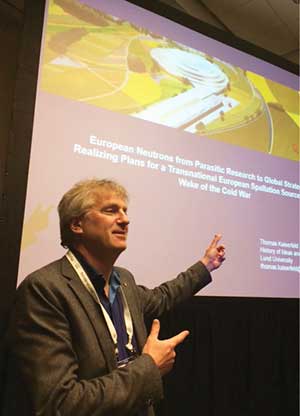Session Report: “The New Big Science and the Transformation of Research”
By B. Catherine Westfall, Michigan State University
The session began with a talk by Catherine Westfall that described a new era in the development of large-scale research as evident in the U.S. national laboratories: the New Big Science. She explained that the change from the Old Big Science to the new began the 1980s when post-WWII emphasis and enthusiasm for basic research waned and interest in industrial participation grew along with the development of stand-alone large-scale materials science accelerators. By the end of the decade the development of the New Big Science was accelerated by efforts to bolster support for the huge (and doomed) high-energy physics accelerator, the Superconducting Supercollider. Early efforts by DOE Director of Energy Research, Alvin Trivelpiece, to reduce intra-laboratory squabbling to help secure the SSC led to a plan that included large projects — including large materials science accelerators — for existing laboratories. When the SSC was cancelled, plans for these accelerators proceeded so that the largest projects in the U.S. national laboratories, by default, were for materials science. The New Big Science that emerged is characterized by greater government accountability that favors practicality and thus greater industrial participation. These traits in turn lead to a highly diverse and sizable user community advantageous to funding prospects, smaller facilities and experiments than the Old Big Science, and a greater propensity for international and multidisciplinary collaboration, especially involving biomedical research.
Crease’s talk built upon Westfall’s by examining the research ecology of the New Big Science at the NSLS II’s precursor, the NSLS. The NSLS, Crease said, can serve as kind of an ecologist’s quadrat or square, a tool used to isolate a representative region in which to analyze an ecosystem. Crease then went on to consider the features of the New Big Science as they were present in research at the NSLS. He also discussed the challenges that the New Big Science poses not only for scientists but also for managers and funders. These include greater bureaucracy and pressure for accountability, issues involving insurance and intellectual property, and the difficulty of promoting such facilities in Congress and to a public used to symbolically significant Big Science machines aimed at Big Discoveries. Crease concluded by suggesting that the New Big Science poses problems for historians as well. It may be necessary, he said, to develop new kinds of digital tools to keep track of and image the complex changing patterns of the New Big Science, bringing the tools of computer analysis and visualization to bear on the study of a single, historically rich, immensely complex instrument of the scale of a synchrotron light source.
The session ended with a talk by Thomas Kaiserfeld that analyzed the development of the European Spallation Source currently being built in Lund in the era of the New Big Science. Kaiserfeld explained how ESS planners have successfully managed to present the project as relevant to different national and international policy makers, to the community of European neutron researchers as well as to different industrial interests. All this has been achieved in a research-policy environment which has been subject to drastic transformations, from calls to engage former researchers from the former eastern bloc in the early 1990s via competition with America and Asian researchers at the turn of the 21st century to intensified demands on business applications. During this process there have also been fierce competition between different potential sites in the U.K., Germany, Spain, Hungary, and Sweden, not once, but twice. The project has in addition been plagued by withdrawals of key actors as well as challenging problems in the field of spallation-source construction. By analyzing the different measures taken and arguments raised by planners, Kaiserfeld explained how the European Spallation Source has survived from the early 1990s until today.

Thomas Kaiserfeld
The articles in this issue represent the views of their authors and are not necessarily those of the Forum or APS.
